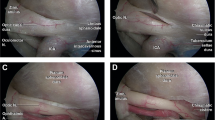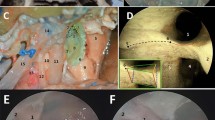Abstract
Background
The endoscopic endonasal opening of the optic canal has been recently proposed for tumors with medial invasion of this canal, such as tuberculum sellae meningiomas. Injury of the ophthalmic artery represents a dramatic risk during this maneuver. Therefore, the aim of this study was to analyze the endoscopic endonasal anatomy of the precanalicular and canalicular portion of this vessel, discussing its clinical implication.
Methods
The course of the ophthalmic artery was analyzed through five endoscopic endonasal dissections, and 40 nonpathological consecutive MRAs were reviewed.
Results
The ophthalmic artery arises from the intradural portion of the supraclinoid internal carotid artery, in 93 % of cases about 1.9 mm (range: 1–3) posterior to the falciform ligament. At the entrance into the optic canal, the ophthalmic artery is located infero-medially to the optic nerve in 13 % of cases. In 50 % of these cases the artery moves infero-laterally along its course, remaining in a medial position in the others. In cases with an non medial entrance of the ophthalmic artery, it runs infero-lateral to the optic nerve for its entire canalicular portion, with just one exception.
Conclusion
The endoscopic endonasal approach gives a direct, extensive and panoramic view of the course of the precanalicular and canalicular portion of the ophthalmic artery. Dedicated high-field neuroimaging studies are of paramount importance in preoperative planning to evaluate the anatomy of the ophthalmic artery, reducing the risk of jeopardizing the vessel, particularly for those uncommon cases with an infero-medial course of the artery.







Similar content being viewed by others
References
Abhinav K, Acosta Y, Wang WH, Bonilla LR, Koutourousiou M, Wang E, Synderman C, Gardner P, Fernandez-Miranda JC (2015) Endoscopic endonasal approach to the optic canal: anatomic considerations and surgical relevance. Neurosurgery 11(Suppl 3):431–446
Ditzel Filho LF, Prevedello DM, Jamshidi AO, Dolci RL, Kerr EE, Campbell R, Otto BA, Carrau RL (2015) Endoscopic endonasal approach for removal of tuberculum sellae meningiomas. Neurosurg Clin N Am 26(3):349–361
Koutourousiou M, Fernandez-Miranda JC, Stefko ST, Wang EW, Snyderman CH, Gardner PA (2014) Endoscopic endonasal surgery for suprasellar meningiomas: experience with 75 patients. J Neurosurg 120(6):1326–1339
Liu JK, Christiano LD, Patel SK, Tubbs RS, Eloy JA (2011) Surgical nuances for removal of olfactory groove meningiomas using the endoscopic endonasal transcribriform approach. Neurosurg Focus 30(5):E3
Mahmoud M, Nader R, Al-Mefty O (2010) Optic canal involvement in tuberculum sellae meningiomas: influence on approach, recurrence, and visual recovery. Neurosurgery 67(3 Suppl Operative):ons108–ons118
Grisoli F, Diaz-Vasquez P, Riss M, Vincentelli F, Leclercq TA, Hassoun J, Salamon G (1986) Microsurgical management of tuberculum sellae meningiomas. Results in 28 consecutive cases. Surg Neurol 26(1):37–44
Perrini P, Cardia A, Fraser K, Lanzino G (2007) A microsurgical study of the anatomy and course of the ophthalmic artery and its possibly dangerous anastomoses. J Neurosurg 106(1):142–150
Raco A, Bristot R, Domenicucci M, Cantore G (1999) Meningiomas of the tuberculum sellae. Our experience in 69 cases surgically treated between 1973 and 1993. J Neurosurg Sci 43(4):253–260
Abuzayed B, Tanriover N, Akar Z, Eraslan BS, Gazioglu N (2010) Extended endoscopic endonasal approach to the suprasellar parachiasmatic cisterns: anatomic study. Childs Nerv Syst 26(9):1161–1170
de Divitiis E, Esposito F, Cappabianca P, Cavallo LM, de Divitiis O (2008) Tuberculum sellae meningiomas: high route or low route? A series of 51 consecutive cases. Neurosurgery 62(3):556–563
Erdogmus S, Govsa F (2006) Anatomic features of the intracranial and intracanalicular portions of ophthalmic artery: for the surgical procedures. Neurosurg Rev 29(3):213–218
Huynh-Le P, Natori Y, Sasaki T (2005) Surgical anatomy of the ophthalmic artery: its origin and proximal course. Neurosurgery 57(4 Suppl):236–241
Kulwin C, Schwartz TH, Cohen-Gadol AA (2013) Endoscopic extended transsphenoidal resection of tuberculum sellae meningiomas: nuances of neurosurgical technique. Neurosurg Focus 35(6):E6
Louw L (2015) Different ophthalmic artery origins: embryology and clinical significance. Clin Anat 28(5):576–583
Martins C, Costa E, Silva IE, Campero A, Yasuda A, Aguiar LR, Tatagiba M, Rhoton A Jr (2011) Microsurgical anatomy of the orbit: the rule of seven. Anat Res Int 2011:468727
Soni RS, Patel SK, Husain Q, Dahodwala MQ, Eloy JA, Liu JK (2014) From above or below: the controversy and historical evolution of tuberculum sellae meningioma resection from open to endoscopic skull base approaches. J Clin Neurosci 21(4):559–568
Author information
Authors and Affiliations
Corresponding author
Ethics declarations
The authors state that the content of this article, in part or in full, has not been published previously and has not been submitted elsewhere for review. No financial support was received in conjunction with the generation of this submission, and there is no conflict of interest. The authors certify that this manuscript is a unique submission and is not being considered for publication with any other source in any medium. The authors have nothing to declare and nothing to disclose.
Funding
No funding was received for this research.
Conflict of interest
All authors certify that they have no affiliations with or involvement in any organization or entity with any financial interest (such as honoraria; educational grants; participation in speakers’ bureaus; membership, employment, consultancies, stock ownership, or other equity interest; and expert testimony or patent-licensing arrangements), or non-financial interest (such as personal or professional relationships, affiliations, knowledge or beliefs) in the subject matter or materials discussed in this manuscript.
Ethical approval
All procedures performed in studies involving human participants were in accordance with the ethical standards of the institutional and/or national research committee and with the 1964 Helsinki Declaration and its later amendments or comparable ethical standards. For this type of study (observational retrospective) formal consent is not required.
Animal experiments
This article does not contain any studies with animals performed by any of the authors
Rights and permissions
About this article
Cite this article
Zoli, M., Manzoli, L., Bonfatti, R. et al. Endoscopic endonasal anatomy of the ophthalmic artery in the optic canal. Acta Neurochir 158, 1343–1350 (2016). https://doi.org/10.1007/s00701-016-2797-1
Received:
Accepted:
Published:
Issue Date:
DOI: https://doi.org/10.1007/s00701-016-2797-1




